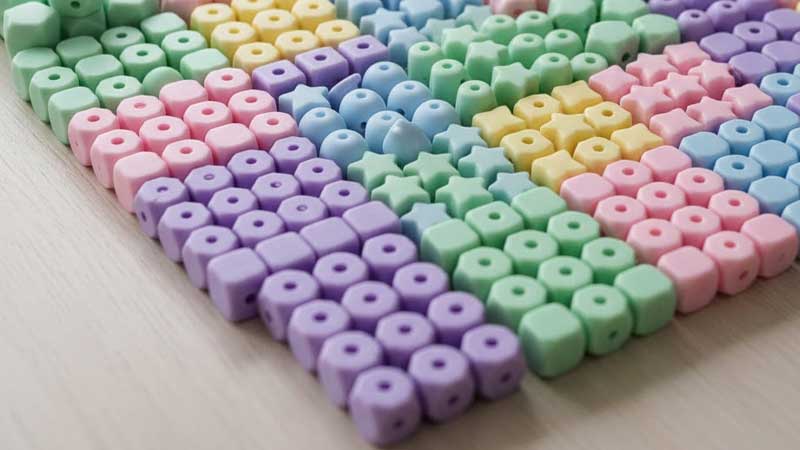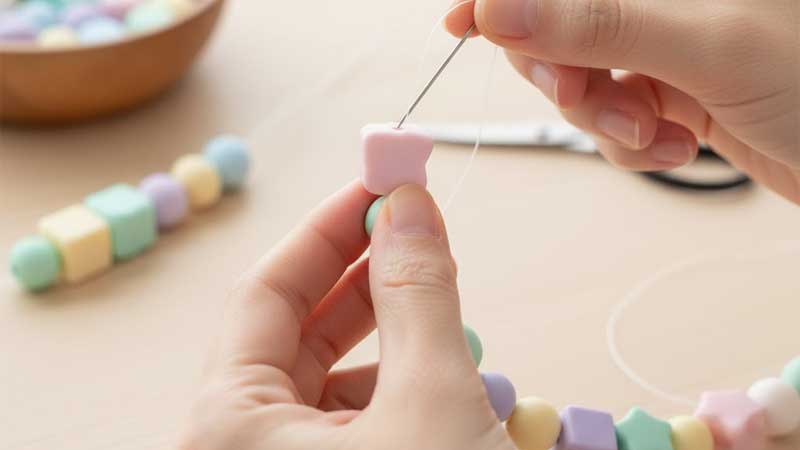Silicone beads are widely used in teething toys, pacifier clips, bracelets, and various DIY accessories. To create high-quality finished products, proper stringing techniques are essential.
This guide provides a comprehensive overview of how to safely and efficiently string silicone beads, covering material preparation, cleaning and disinfection, stringing methods, and finishing techniques, ensuring each piece achieves the desired result.

How to Prepare Before Assembling Silicone Beads?
Choose the Right Accessories and Materials
A successful assembly begins with choosing the right materials. Each cord, clasp, and accessory plays a key role in the product’s durability and safety.
Common stringing materials include:
- Nylon cord: Strong, wear-resistant, and less likely to break. Ideal for pacifier clips, teething chains, and keychains. Its surface is smooth, so it threads easily, but knots should be double-secured.
- Polyester or satin cord: Smooth, soft, and available in many colors. It works well for necklaces and bracelets with a more decorative purpose.
- Elastic cord: Stretchy and comfortable to wear, suitable for bracelets or hair accessories. However, it’s not recommended for baby products because of the risk of snapping under tension.
When choosing the cord, make sure its diameter matches the bead hole size. If the cord is too thin, beads may loosen. If too thick, it can damage the hole wall. The best fit allows the cord to slide through easily while staying snug.
For baby products, selecting safe clasps is especially important.
- Breakaway clasps: Release automatically when pulled, reducing the risk of choking. Often used for teething necklaces or pacifier clips.
- Threaded or metal clasps: Provide a secure hold and a polished look, suitable for adult jewelry. Metals should be nickel- and lead-free to prevent skin irritation.
Professional makers may also add spacer beads, silicone locks, or stopper rings to control bead movement and improve design aesthetics.

Cleaning and Disinfection
Before assembly, cleaning and disinfection are essential for hygiene and safety.
During transport and storage, silicone beads can collect dust, oil, or residues. Using them directly may cause stickiness or weaken bonding.
Recommended cleaning steps:
- Wash each bead gently in warm water with mild, unscented soap to remove dirt and grease.
- Rinse thoroughly with clean water to eliminate any detergent residue.
- Lay the beads flat on a clean towel and let them air dry naturally. Avoid sunlight or heat drying.
- For baby products, use steam sterilization or boil the beads for 3 minutes to ensure deeper disinfection.
- After cleaning, store the beads in a clean, sealed bag or container to prevent contamination.
Before handling, wash your hands and wear disposable gloves. If you reuse tools like threading needles, scissors, or pliers, wipe them clean or disinfect with food-grade alcohol. These simple steps are the foundation of safe and hygienic assembly.
How to Assemble Silicone Beads Safely?
Design Planning
Start with a clear design plan.
Depending on the purpose, such as teething chains, necklaces, or keychains, decide on color combinations, bead arrangement, and total length. Balance safety with visual appeal.
For baby products, keep these points in mind:
- Avoid very small beads. The diameter should be at least 15 mm to prevent choking.
- Limit total length. Generally, the finished length should not exceed 22 cm.
- Keep proper spacing. The design should remain flexible and not overly tight.
You can use spacer beads or shaped beads to add layers of color and texture.
For mass production, it’s best to create a sample or CAD design to confirm proportions and safety features before assembly.

Stringing Method
How you string the beads affects the strength and durability of the final product.
Common techniques include:
- Single-strand threading: Simple and lightweight, ideal for accessories like keychains or bracelets. Keep tension even while threading to avoid twisting or tangling.
- Double-strand threading: Provides extra strength for baby pacifier clips and teething chains. The double structure improves resistance to pulling and twisting.
Use a stainless steel threading needle or fine wire to help guide the cord through the beads.
After threading each bead, gently tighten the cord to keep the beads aligned but not compressed, allowing silicone to stay flexible. Add stopper beads or knots at key points to prevent sliding. If you plan to attach charms or letter beads, fix their positions early to avoid rethreading.
Finishing and Securing
The final step is crucial for product stability and safety.
Common knotting methods:
- Surgeon’s knot: Prevents slipping and works well for nylon or polyester cords.
- Double knot: Adds another layer of security on top of the first knot.
- Heat sealing: Lightly melt the ends of nylon cords with a lighter to prevent fraying. Keep a safe distance to avoid burning.
For baby products, apply a small drop of food-grade silicone glue or anti-slip coating on the knot for extra hold.
Before use, perform a pull test by tugging on the knot and clasp to confirm they stay secure. For mass production, use a tension tester for consistent results.
Finally, check that the overall structure is balanced and beads are evenly spaced. Wipe the surface with a clean cloth to remove any residue, leaving the finished product safe, smooth, and ready to use.

Common Mistakes and How to Avoid Them
To help makers prevent issues, here is a list of common mistakes in assembling silicone beads, their possible consequences, and the correct practices to follow:
| Mistake | Consequence | Correct Practice |
| Using cords that are too thin or weak | Insufficient strength, easy breakage | Choose high-strength nylon or polyester cords |
| Over-tightening silicone beads | Beads deform, holes crack | Maintain proper spacing between beads |
| Knots not secured or ends not sealed | Beads may slip, structure becomes loose | Use double knots or heat sealing to fix securely |
| Not cleaning silicone beads | Beads may carry dust or bacteria | Wash and air-dry beads before stringing |
| Mixing low-quality silicone beads | Color may fade, unpleasant odor | Use beads certified by FDA or LFGB |

Conclusion
From selecting materials and cleaning to stringing and finishing, every step affects the texture and durability of the final piece. Careful planning, attentive execution, and consistent cleaning ensure that each silicone bead creation is not only beautiful but also reliable. This approach guarantees long-lasting comfort and allows every piece to withstand regular use.
Discover the full potential of silicone. With over 10 years of experience and advanced production technology, our company ensures high-quality, reliable custom silicone products. Contact us today to create pieces tailored to your brand and design vision.